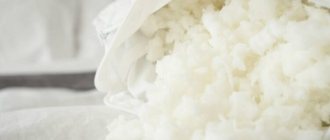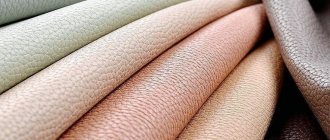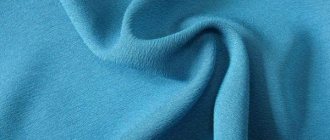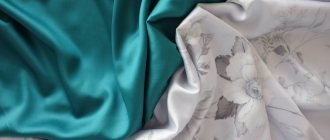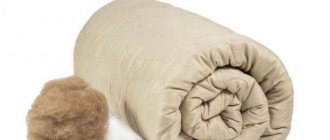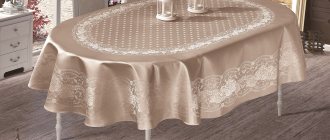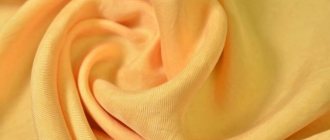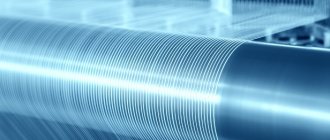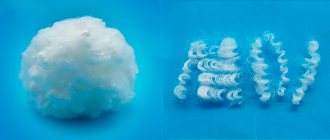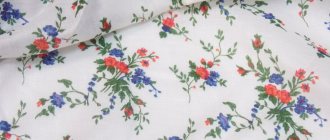Secrets of bamboo fiber production
The traditional option for obtaining bamboo fiber involves mechanical processing of raw materials.
The bamboo is crushed, then fermented until smooth, after which the individual fibers are separated from it. The resulting product is ideal for the production of textiles and fillers. All fibers have the same density, length and strength. However, this option for producing bamboo fiber requires significant effort and time. For this reason, large-scale production uses a modern chemical method for processing raw materials. Is the bamboo fiber obtained this way dangerous? What is this - a chemical option for processing natural raw materials?
The use of special reagents can significantly simplify and speed up the fiber processing process. Moreover, the final product is completely safe for the consumer, since all chemicals are removed during production.
Production
Bamboo fiber is an innovative product. It belongs to a type of regenerated viscose fiber and is obtained by processing the stem of a plant.
For production, a plant that has reached 4 years of age is used (unlike trees that need to be at least 30 years old). It is also interesting that when growing it you do not need to use artificial sprayers and chemical compounds - harmful insects do not attack this plant. Its main property is the destruction of bacteria, so harmful insects do not approach bamboo.
Fiber can be “extracted” in several ways:
- Chemical;
- Mechanical.
The chemical production method is similar to the creation of viscose. It is not so simple and safe. To begin with, the stems are crushed to the state of shavings or sawdust. The resulting mass is treated with potassium or caustic soda, resulting in the creation of an adhesive-like composition. Next, this mass to obtain fiber must be passed through special devices with many perfectly round holes. The latter are steel plates with holes, the diameter of which is no more than 6-30 microns. The holes are burned with a laser beam. The quality of the resulting threads depends on their shape and size. The adhesive composition is alkaline in nature, so to complete the reaction it must be placed in an acidic environment. This is necessary to neutralize the composition. As a result, the fibers harden and cellulose is restored from the bamboo.
The production itself is harmful primarily for workers; there is no danger for end consumers, since all reagents are thoroughly washed away.
Interesting fact
Even in the production of cotton or wool, chemical compounds are used, but no one is wary of these materials, considering them “natural” and environmentally friendly.
The resulting fibers have a porous structure and small fibers. This structure has a beneficial effect on the quality of the finished product.
Read about: domestic insulation Shelter
Mechanically produced fabric is sometimes called "bamboo flax". This is a safe but labor-intensive process.
To do this, the “woody” part of the bamboo is crushed mechanically, rather than using reagents. Next, the resulting mass is processed with natural enzymes and brought to a homogeneous state. It is similar to the method used in the production of flax. Threads are drawn from the resulting mass. Typically the fiber length is 15-20 cm. The structure is pentagonal. Fiber made in this way is more expensive, but it is impossible to distinguish them externally.
Watch a video of how bamboo fabric is made:
If it is important to you how the fabric or filling was obtained, look at the markings. Although many, so the method of production remains a mystery!
Advantages of bamboo fiber
Bamboo fabrics have a natural shine and smoothness.
Products made from them are very soft to the touch, more delicate than cotton. Bamboo fiber has a high density. Thanks to this characteristic, it does not wrinkle, is easy to drape and perfectly holds its given shape. Bamboo fiber also has all the traditional advantages of natural fabrics. What it is is easy to understand from the first use of bed linen made from this material. The fabric is breathable and highly hygroscopic. Thanks to this, it perfectly retains the heat of the human body in winter and prevents overheating in summer.
Bamboo is also used to make environmentally friendly filling for blankets and pillows. Bamboo fibers do not cause allergies, do not accumulate static electricity, and have antibacterial properties. Evergreen grass is never attacked by insect pests and does not rot. Accordingly, products made from bamboo fiber are durable. They also have natural protection against bacteria and parasites.
Composition and properties
Modern bamboo fabric is a material of natural origin. Even if the fabric was produced chemically, no harmful substances remain in it, and it is an absolutely safe textile for the environment. The composition is dominated by bamboo fibers, spun into a thin thread from which the fabric is created.
Bamboo knitwear, plain composition: bamboo 94% elastane 6%.
To improve properties and improve performance, manufacturers can add synthetic fibers, such as polyester. It increases the strength of matter. If you add lycra to bamboo fabric, the finished textile will be more elastic.
But most often we are talking about 100% bamboo fabric, the properties of which we have already mentioned above.
Another popular fabric in the sewing industry is made from bamboo. It belongs to non-woven and is obtained by fastening together threads that are sensitive to high temperatures. It is a thermally bonded bamboo fiber that is most often used as filler. Also interesting and unusual textiles.
Disadvantages of bamboo fiber
According to some experts, bamboo will very soon displace the most common cotton today from the textile industry market.
Indeed, bamboo fiber has a lot of advantages, and the cost is quite reasonable. What about the disadvantages? As a raw material for making fabrics and a filler, bamboo fiber attracts manufacturers because it is highly hygroscopic. The ability to quickly absorb large amounts of moisture is usually considered an advantage of natural materials. But in some cases it is a disadvantage. Bamboo products are not the best option for constant use in high humidity conditions.
Care
Bamboo is undemanding in care. Even blankets made from it can be washed in a machine, but on a delicate cycle, at a temperature of 30°C. Washed this way, they do not shrink. It is advisable to spin it manually so that the fabric does not twist too much. Dry vertically in natural conditions. But still, dry cleaning is preferable for pillows and blankets. Dry cleaning is strictly prohibited, as are bleaches.
We recommend that you carefully read the accompanying labels. They always indicate exactly how to wash any bamboo product. Although, everyday or household things usually do not require any complex actions. And yet, carefully study the information from the manufacturer in order to properly care for and extend the life of your clothing.
Dear readers of the Tkan.Club website, if you still have questions on this topic, we will be happy to answer them. Leave your reviews, comments, share stories if you have dealt with this material! Your life experience may be useful to other readers.
Application area
In modern industry, bamboo fiber is used to make fillers and fabrics. Due to its characteristics, bamboo is ideal for creating clothing and home textiles. Bamboo fiber also has positive reviews as a natural filler for pillows and blankets. These bedding can be washed in a washing machine and dried outdoors.
Bed linen, protective covers for mattresses and pillows, tablecloths, and towels are also made from bamboo fiber. Bamboo fabrics are also used for sewing casual clothing, sports kits, and medical equipment.
Bamboo
Bamboo is a plant that has unique qualities that allow it to be used in various fields. But the most popular area of application for bamboo is the textile industry.
Bamboo is a textile with amazing properties. Bamboo fabric is an excellent material for the production of bed linen, blankets, pillows and other home textiles. In addition, bamboo has antibacterial and hypoallergenic properties. This makes it even more in demand.
Content
- Production technology and textile features
- Main properties and characteristics
- Application of bamboo textiles
- Features of care
Production technology and textile features
To date, scientists have not decided what type of bamboo fabric to classify: artificial or natural. Bamboo is a plant that is processed mechanically and chemically for use in light industry. It is the production process that causes controversy as to what type of bamboo textiles should be classified.
In texture and feel, bamboo fabric resembles viscose. The manufacturing process is also similar to that of viscose fabric.
Stages of making bamboo fiber:
- First of all, the bamboo is crushed to the state of fine sawdust.
- Afterwards, it is treated with potassium to obtain a composition resembling glue. The processed material is passed through special equipment.
- And the last stage of processing is to place the treated mixture in an acidic environment to neutralize the alkaline nature.
As a result, the textile has a rough surface and texture. If you swipe across the fabric and it is smooth, then this means that you are looking at artificial textiles. Natural bamboo fabric is dense and textured.
Main properties and characteristics
Bamboo textiles have a lot of advantages and positive properties, including:
- Durability and breathability.
- Hygroscopicity. Moisture is absorbed easily and quickly, leaving no marks or streaks.
- Thermal insulation. In winter, textiles can accumulate and store heat for a long time.
- Bamboo textiles do not absorb unpleasant odors and are resistant to UV rays, which is ideal for summer.
- The textile has a good color pigment and is highly wear-resistant. This allows you to maintain the bright color or whiteness of textiles for a long time.
- The material is hypoallergenic and antibacterial. It is ideal for allergy sufferers, people with sensitive skin and children.
- Textiles are easy to care for.
Bamboo fabric has no disadvantages. Apart from the high cost, which is more than compensated for by its positive properties and characteristics.
Application of bamboo textiles
One of the most popular uses of bamboo is home textiles. Bamboo thread is ideal for sewing lightweight home clothing, bed linen, pillows and blankets.
Bamboo knitwear is a popular material that has a number of positive properties:
- Clothing and textiles retain their whiteness and bright colors for a long time.
- The fabric has bactericidal properties.
- Resistant to UV rays.
- Textiles do not absorb unpleasant odors.
Bamboo is often used to fill blankets and pillows. Such products will not only have thermal insulation qualities, but will also be very light and durable. Pillows filled with bamboo are elastic, soft and hold their shape perfectly.
Bed linen made from bamboo is ideal for a sound, healthy sleep. The fabric does not lose its shape and color brightness. It is always soft and pleasant to the touch.
Features of care
Blankets and pillows filled with bamboo fibers require special care. It is worth knowing that you should not subject the products to frequent washing. If this is necessary, the following recommendations should be followed:
- Do not wash in water temperatures above 30 C;
- Do not add chemical detergents with an aggressive bleaching composition;
- Blankets and pillows should be dried in a hanging position;
- Under no circumstances should you iron products made from bamboo fabric and fibers. When exposed to high temperatures, the product may become deformed.
In the same way, you should care for bedding and clothing made from bamboo fiber. Care is not so difficult, if you stick to it, the textile will last a long time and retain all its positive characteristics and properties.
Bamboo is such a popular material for a reason. In addition to the fact that bamboo fabric is applicable in many areas, wallpaper, children's dishes and many useful things for the home are made from the plant.
Bamboo fabric is a safe material that is ideal for allergy sufferers and small children. The material is easy to maintain and has a long service life.
Bamboo products have only positive characteristics, which makes products made from this material so popular all over the world.
#fiber #textiles #bed linen fabrics #fabric
Clothes, bedding and blankets made of bamboo fiber: reviews
Bamboo products today can be purchased at any large textile store.
When purchasing, do not hesitate to examine the item you like in detail. Real bamboo is very soft and pleasant to the touch. It does not crunch when compressed and easily restores its shape after deformation. Remember also that any natural material cannot be cheap. But is real bamboo really that good? A blanket made of bamboo fiber has positive reviews due to its softness, wear resistance and lightness. You can sleep under this product all year round.
Clothing and home textiles made from bamboo perfectly absorb liquid, are incredibly pleasant to the touch, and retain an attractive appearance for a long period of time. If you believe the reviews, it is enough to purchase at least one product made from this material in order to personally appreciate bamboo fiber. Today, more and more of our compatriots are learning what it is. Try the incredible softness and lightness of natural bamboo fiber!
Material properties
The widespread popularity of bamboo fabric is based not only on fashion and successful marketing policies. Scientific research and consumer reviews reveal many beneficial properties that make this innovative fiber superior to its competitors:
- high environmental friendliness of raw materials;
- excellent hygienic and health-improving qualities;
- hypoallergenic;
- high strength, and at the same time softness, elasticity and breathability (20% higher than natural cotton);
- it has been proven that environmentally friendly bamboo fiber kills up to 70% of bacteria that come into contact with it per day, and this effect lasts up to 5 washes;
- bamboo clothing blocks up to 100% of ultraviolet radiation;
- silky bamboo is very pleasant to the touch, never causes abrasions or irritation and promotes their healing;
- this fiber has an increased ability to absorb water and unpleasant odors;
- it practically does not wrinkle, washes well and retains its attractive appearance and consumer properties for up to 500 washes.
Thus, the experience of using this innovative fabric for clothing, home textiles and bed linen confirms numerous positive reviews about it. In such clothes it is impossible to sweat and overheat, they will reliably protect from cold and sun, relieve allergic and other irritations, and at the same time they are quite durable and comfortable to wear .
What is important is that bamboo fiber retains its environmental properties even during the recycling process: the discarded item decomposes in the same way as plant residues, without polluting the environment.
What is bamboo fabric
Bamboo is an evergreen perennial plant with a hard, woody, hollow stem.
Bamboo fabric is used not only in textiles
There are hundreds of varieties that are successfully used in various areas of human activity - from construction to medicine.
Natural bamboo
Note! Bamboo is a wonderful and highly versatile natural resource. It has been used for many centuries in Asia in a variety of applications, including cooking, construction, transport, textiles and medicine.
Bamboo fiber can be used to make exceptional modern textiles.
How do you get it?
Bamboo filler in a pillow or blanket is obtained in two ways:
- Labor-intensive mechanical. The product is called bamboo flax.
- Eco-friendly chemical. They use safe reagents (they are also used in wool production and cotton cleaning). The substance does not remain on the mass. The bamboo filling in pillows and blankets is absolutely clean and hygienic.
Bamboo fiber is gradually replacing cotton and linen. Such vast fields are not needed for its cultivation. The plant is cut, but it grows in the same place.
Properties of bamboo threads
Bamboo fiber has gained popularity in many countries in Europe and Asia. In terms of its characteristics, it surpasses not only other artificial fibers, but also cotton, which is considered one of the highest quality materials. Bamboo threads contain natural components, so products made with these fibers do not harm humans and nature.
Bamboo has many advantages:
With bamboo textiles you can achieve a comfortable microclimate. The material takes a long time to dry, but this is its only feature that housewives rarely complain about.
